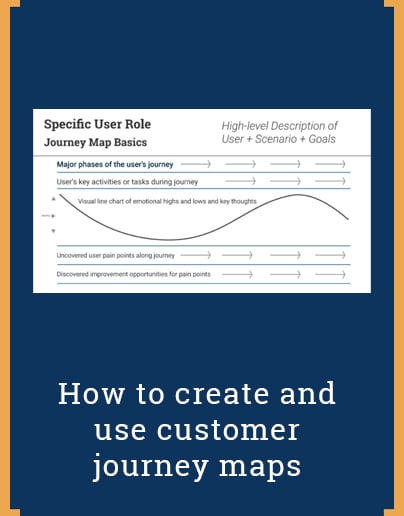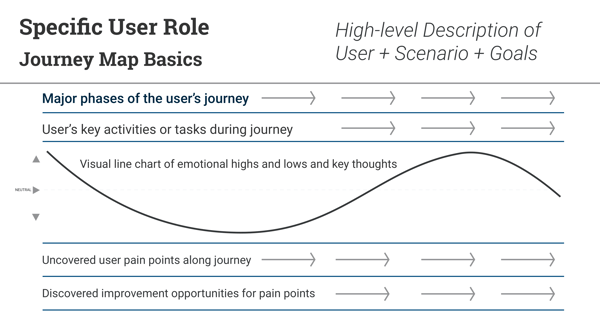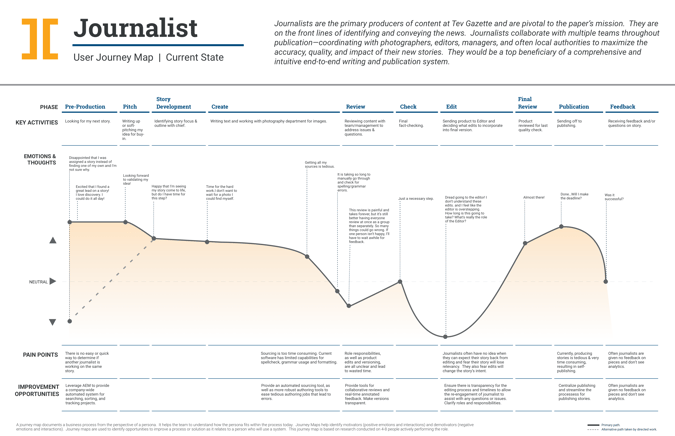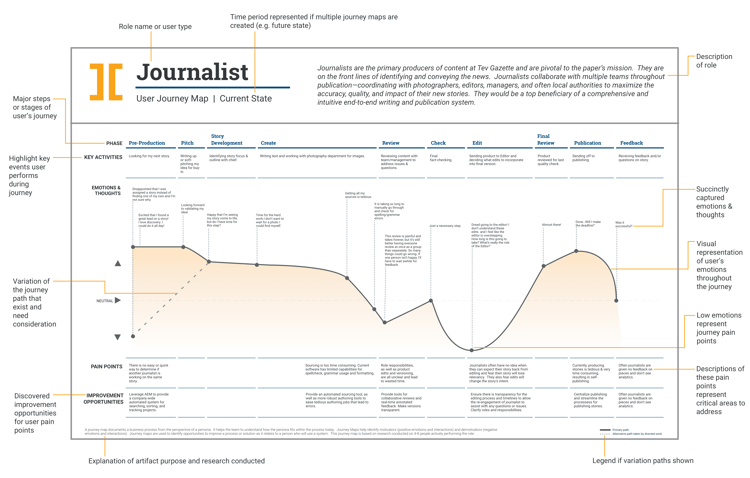Why use journey maps?
A government client of ours routinely published content and wanted to improve their content production process. Managers were frustrated because the writing staff would routinely circumvent the mandated process because they felt it took too long to follow. Circumventing led to faster content production, but at the high cost of quality and accuracy.
We were asked to come in and help accelerate content production, while simultaneously improving content timeliness, accuracy, and quality. A seemingly tall order, we knew the only way we could succeed was to really understand the goals of the production process and what the writing staff experienced during every step. Only then would we understand why the process wasn’t working and how we could fix it. We started by creating user journey maps.
What are journey maps?
Journey maps articulate user (customer or end-user) pain points and opportunities, yet they are still widely under-used by organizations. Done correctly, a journey map tells the story of your target user and the experiences he or she goes through when interacting with your organization. It represents a timeline of customer activities, emotions, and organization touchpoints.
Journey Maps can be used by designers, marketers, product managers, and developers to create user empathy and provide context on how a user experiences your organization or a product / service within it. Journey maps identify user motivators (positive emotions and interactions) and demotivators (negative emotions and interactions) that can be used to identify opportunities to improve a process or solution as it relates to a particular user experience.
|
Customer's Journey |
Buyer's Journey |
User’s Journey |
|---|---|---|
|
The customer's journey is a visual representation of the stages people (end-users or customers) go through when buying and/or experiencing a product. It is often seen as a loop consisting of: |
In B2B sales, and complicated B2C sales, the buyer and the customer may be separate. Alternatively, the buyer's journey may be a subset the Customer’s Journey. |
While a Customer Journey represents the whole lifecycle of a customer, a user journey is used within UX to zoom into how a user experiences a specific product or service, including what screens they click on. |
|
|
|
Within our work, we most often create user journeys because of their flexibility to validate broad product experiences or clarify specific services.
Download our customer journey map templates.
How we used journey maps
For our government client, we created user journeys for each employee role that engaged in the content production process. We held collaborative workshops with employees and mapped all major steps of the content process from their point of view. We then asked employees in each role to provide insights into their thoughts and emotions during each step of the content production process.
By focusing on each user’s emotional journey, we were able to identify the biggest pain points of the content production process. The negative emotions revealed why so many preferred to circumvent the process, which has less to do with how long the process was, but more to do with lack of transparency and trust between departments. This was eye-opening and unexpected for management.
Creating user journey maps served many purposes for us.
- It informed our development roadmap. By focusing on the areas with the most pain, or negative emotions, we were able to prioritize where to start our improvement process and identify the areas with the greatest value return. The creation of a shared backlog served to align departments on less critical improvement areas to tackle in future phases.
- It provided context. By speaking to the actual people who performed the work, we could hear straight from the source what the problems were rather than make assumptions. Observing employees doing their actual work often allows us to capture the insights they didn’t know how to articulate.
- It created trust. Each person we spoke to better understood why we were trying to change the process in which they worked and quickly became advocates for that change, rather than be resistant to it. This is key. If you allow people to have a hand in shaping a new process or decision, they are far more likely to support it.
User research is the foundation of journey mapping—without research it’s easy to overlook key insights and simply take management’s word for it. In our case, journey mapping uncovered that the length of the content production process was merely a symptom of the problem and not the root issue at all.
Creating your own journey maps
Best Practices
- Create a well-defined customer or user journey. A great journey contains four key pieces of information:
-
- Header with user / role name and short description of user’s scenario or goal. Often journey maps are created hand-in-hand with personas and use the same user / role names.
- High-level journey phases (what we like to call dinosaur steps) that the user goes through. These phases are well-known and helps break down the user’s journey into a series of big steps: discover, buy, use, etc.
- A visualization of the emotional highs and lows the user goes through when interacting with your organization or product, complete with short activity descriptions and thoughts to help explain what the user is doing and feeling during each step of the journey.
- Pain points and opportunities uncovered during the user’s journey. Any emotional low that involves frustration, confusion, disappointment, etc, for the user is an opportunity for improvement that should be called out by the research team.
-
- Keep journey maps brief. As a rule of thumb, avoid adding extra details that are not directly relevant and cannot be used to influence the design. If it does not affect the final design or help make any decisions easier: omit it.
- Focus on real scenarios and jobs to be done. The usefulness of journey maps comes from the real research with users that backs them. Focus on real sequences of events that represent key moments for your users. Conduct user interviews and workshops to fill out journey maps.
- Socialize the journey maps. Convert the journey maps into posters and hang them in areas visible to all teams—break room, conference room, developer's’ workspace area. Share the journey maps with stakeholders, even outside the immediate project space, to help drive user awareness and empathy.
- Get started with journey mapping by downloading one of our templates. Our templates are available in PDF and Sketch format.
Intevity is a digitally-focused management consultancy. Since 2003, we have been delivering world-class service to Fortune 500 companies across Financial Services, Healthcare, Insurance, Media and Retail as well as Non-Profit and Government Agencies. Through design thinking, pattern recognition, and deep technical acumen, we execute end-to-end solutions organized around meaningful business outcomes.





